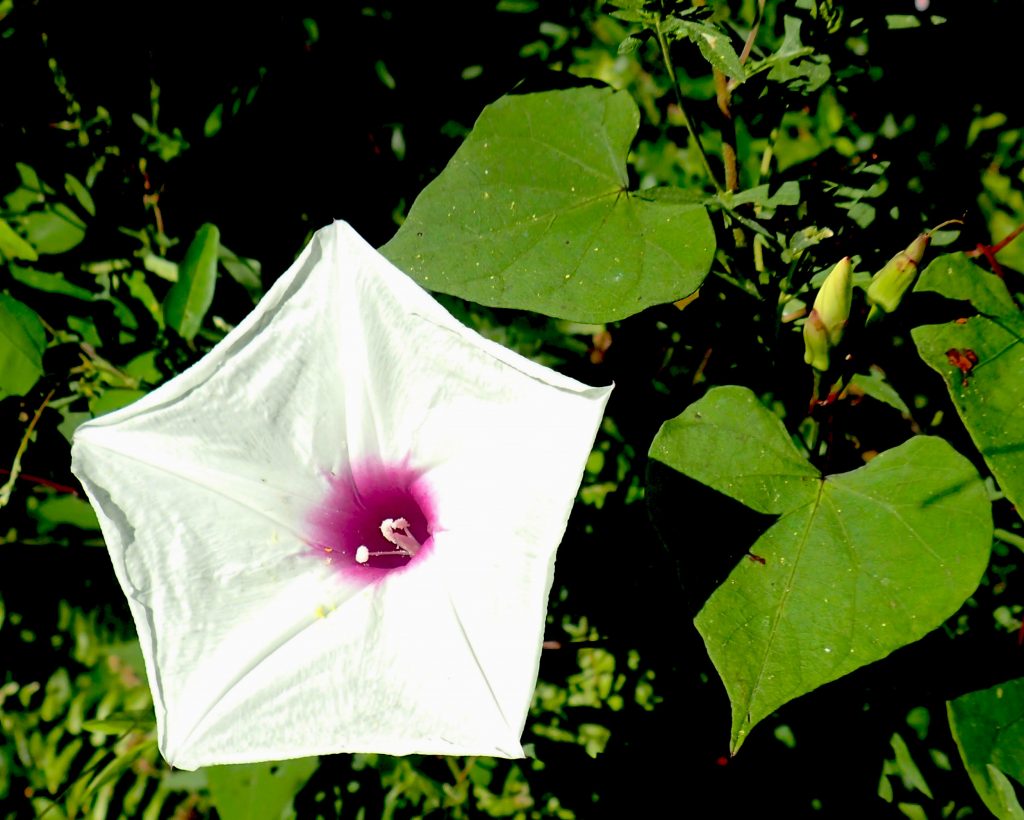
Always investigate Morning Glories that have big white blossoms. Photo by Green Deane
While teaching a foraging class in Gainesville an area had been cleared by controlled burning. There were several wild edibles taking advantage of the burn among them Maypops and Morning Glories. You can tell instantly if a Morning Glory is one you’re interested in. How? Let me tell you what I tell my foraging classes.
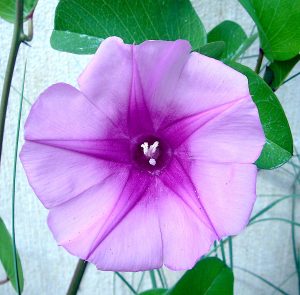
Pink Morning glories can be iffy. Photo by Green Deane
After about 40 years of foraging I was organizing my Morning Glory information one day. Some are edible, some are famine food — eaten now and then or in small quantities. A few are mind altering. I did not have a flash of brilliance but one of color. Species of Morning Glories with blue blossoms are usually not edible, often they can make you ill while simultaneously getting you high by having the LS part of LSD. Species of Morning Glories with pink blossoms are usually not edible and or are a famine food, kind of 50/50, some edible in small amounts for a while, some not edible at all. They also tend to be coastal. And I ignore small white Morning Glory blossoms or small white Morning Glories with a ruby throat. They might have a bit of cyanide in them, such as the Alamo Vine. However… large white Morning Glory blossoms or large white Morning Glory blossoms with a ruby throat usually have something edible. Large in this case means blossom at least three to four inches long or longer. Which part is edible depends upon the species. It might be the blossom, leaves, root, or the entire plant. With this rough guide you can glance at a Morning Glory blossom and know whether to look further. To read more about Morning Glories go here.
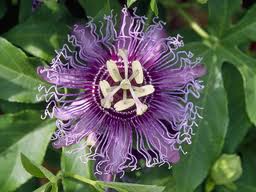
Maypops smell like gym shoes. Photo by Green Deane
It’s June and Maypops are popping out all over. They are easy to find: Look for a vine that has three-lobed leaves and smooth, green fruit shaped like a large egg to a tennis ball. The fruit ripens to yellow near the base of the vine first. The plant, which smells like an old gym shoe, will put on new fruit until cold weather. Green fruit can be fried like green tomatoes. Sometimes the green ones have seeds mature enough to be tart. Sweet and sour seeds can be scooped out of the yellow fruit and eaten along with their white jelly-like coating. Locally our most common passion fruit is Passiflora incarnata, right. You will read on the Internet that it contains cyanide. It does not though many passion fruits do if not all but P. incarnata. It was specifically tested and definitely does not have cyanide in it’s leaves. The varying amounts of cyanide in other species of passion fruit is one reason why animals don’t eat them and one reason why you should not eat any ornamental passion fruit you may have. Instead of cyanide P. incarnata has GABA, gamma-Aminobutyric acid, which calms you down. It might be a possible anti-dote for Water Hemlock poisoning in that Water Hemlock breaks down the body’s reserve of GABA.
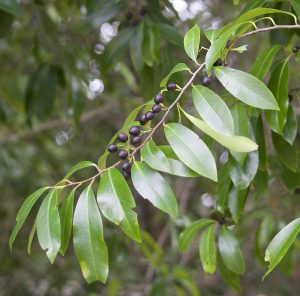
The Cherry Laurel is deadly. Do not eat it. Photo by Green Deane
Mentioning cyanide many plants have it, including several edible species, Chaya for example. Mechanical breaking down of plant cells or cooking often gets rid of the cyanide which many times is bound together either with sugar or hydrogen. Sometimes the plant has to be fermented so the bacteria can eat the glucose thus freeing the cyanide to be rinsed away. Clearly one wants the cyanide to be released outside of the body not during digestion. The toxic non-edible Cherry Laurel is a common poisonous plant with the cyanide bond. If you crush a leaf you can smell either almonds or “maraschino” cherries. That’s cyanide. However, there is one interesting fact you should keep in mind: Depending where you are only 25 to 40% of the population can smell cyanide. It’s a gene-linked thing. If you can crush several Cherry Laurel leafs and not smell almonds or “maraschino” cherries you might be one of those who cannot use their nose to detect cyanide. You can, however, look at the backside of the leaf near the stem and find two faded dots. Those can help you identify it.
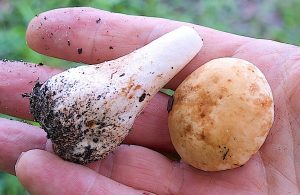
An edible Bolete with no common name, Gyroporus subalbellus. Photo by Green Deane
It has to be the rhythm… A song by the group “America” has been on my mind of late. The lyrics are “I’ve been through the desert on a horse with no name.” Except I hear “I’ve been cookin’ in the kitchen with a Bolete with no name…” There are seven Gyroporus mushrooms in North America. I see two regularly: G. castaneus (the Chestnut Bolete) and G. subalbellus, the nameless Bolete. The Chestsnut Bolete, however, is well-named. The cap has a nice rich chestnut color. And of course as a Bolete it does not have gills but rather pores. It does not stain when bruised and usually has a hollow stem. It’s the other one I have eaten several of thus far this year, G. subalbellus. It has a pale cap, buff, yellowish, pinkish. It’s pore bruise slowly to pink. There is often pink on the stem which is bulbous at the base and usually partially hollow. They both have a good flavor and texture.
Unless you’re an advanced mushroom hunter you can use these rules to eliminate any Boletes that might make you sick (not counting for the wild card allergies.) Do not eat any Boletes with pores that are red or orange, do not eat any Boletes with an orange cap, do not eat any Boletes that stain blue or green. Do not eat any bitter Boletes. There are some edible blue staining Boletes but that is a more advanced challenge.

Classes are held rain or shine or cold.
Foraging Classes: It’s always fun to go to Jacksonville and see what the more northernly plants are doing. And Melbourne has the coastal influence; always interesting.
Sunday June 24th, John Chestnut County Park: 2200 East Lake Road, Palm Harbor, FL 34685. Meet at the trail head of the Peggy Park Nature Walk, pavilion #1 parking lot. 9 a.m.
Saturday, June 30th, George LeStrange Preserve, 4911 Ralls Road, Fort Pierce, FL, 34981. 9 a.m.
Sunday July 1st: The Orlando Mushroom Group will have its July mushroom hunt with Joshua Buchanan July 1st at Markham Trail Head, 8515 Markham Rd, Lake Mary, FL 32746, Time: 9 a.m. Fee: $10 per adult. Rain or shine (except hurricanes.) Dress for walking, mosquitoes and ticks. This are reliably produces Chanterelles, various Boletes, Lactifluus, Puff Balls, Russulas and non-edible mushrooms such as Amanitas and Hydenellums.For more information go to the Facebook page Orlando Mushroom Group.
Saturday, July 7th, Blanchard Park, 10501 Jay Blanchard Trail, Orlando, FL 32817. 9 a.m. Meet at the pavilion east of the tennis courts near the YMCA.
Sunday, July 8th, Jervey Gantt Recreation Complex, 2390 SE 36th Ave., Ocala, FL, 34471. 9 a.m. Meet at the entrance to the pool, aka Aquatic Fun Center.
Saturday July 14th, TBA
Sunday July 15th, Eagle Park Lake, 1800 Keene Road, Largo, FL 33771. 9 a.m. Meet at the pavilion near the dog park.
To read more about the classes go here.
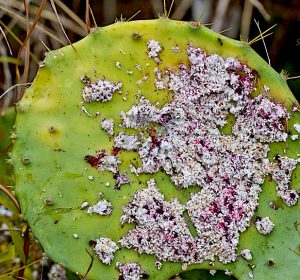
The little red bugs make a white cottony home on a cactus pad.
You eat a lot of bugs, you just don’t know it. For example: One cactus species is called Opuntia cochenillifera. Cochenillifera in Dead Latin means “cochineal bearing” but is from the Greek word for red, “kokinos.” That’s because the cochineal insect lives off the cochenillifera cactus and others. You might find that almost interesting except you’ve eaten that exact insect or more specifically a product produced from their crushed, little dehydrated bodies: Cochineal dye, also called “Tuna Blood.” Actually, only the female cochineal bug provides the red dye and it takes some 75,000 to make one pound, 155,000 to the kilogram. Sometimes in the wild you will see a Nopales or an Opuntia mottled with white or gray, or even covered with white or gray cotton-like covering. That’s a cochineal condo. The hard part is each of the scale-like insects has to be harvested by hand, when they are around 90-days old.
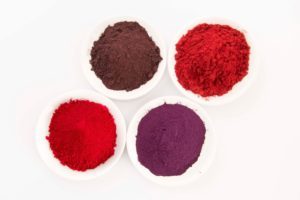
Several food and cloth dyes can be made form the little Cochineal bug.
Before artificial dyes were invented, cochineal dye was the main red dye from fabrics to food. In the 1400s, eleven cities conquered by Montezuma each paid a yearly tribute of 2000 decorated cotton blankets and 40 bags of cochineal dye. During colonial days Mexico had a monopoly on cochineal dye and it was that country’s second largest export after silver. Cochineal went out of favor and flavor when chemical dyes came in but the organic movement and rejection of artificial dyes has brought it back. Cochineal trumps chemicals, as it were unless you’re a vegetarian who have protested its recent incursion into “natural” foods. Some oppose its use because the only religiously approved insect to consume is the locus. If you use a cosmetic — red lip stick for example — or have eaten a product with any of the following ingredients, you have used or bitten the bug as they are all different names for the same insect coloring: Cochineal Extract, Carmine, Crimson Lake (or Lac) Natural Red 4, C.I. 75470, E120, or even “Natural Coloring” when the product is any shade of red, scarlet, purple or orange. Cochineal is also one of the few water-soluble dyes that resist fading. It is used also in slide staining (you remember those pink slide from biology 101 don’t you?) There is a bug in your past, and probably your future.

Green Deane Forum
Want to identify a plant? Looking for a foraging reference? Do you have a UFO, an Unidentified Flowering Object you want identified? On the Green Deane Forum we chat about foraging all year. And it’s not just about warm-weather plants or just North American flora. Many nations around the world share common weeds so there’s a lot to talk about. There’s also more than weeds. The reference section has information for foraging around the world. There are also articles on food preservation, and forgotten skills from making bows to fermenting food. One special section is “From the Frightening Mail Bag” where we learn from people’s mistakes. You can join the forum by clicking on the button in the menu line.

Green Deane DVD Set
All of Green Deane’s videos available for free on You Tube. They do have ads on them so every time you watch a Green Deane video I get a quarter of one cent. Four views, one cent. Not exactly a large money-maker but it helps pays for this newsletter. If you want to see the videos without ads and some in slightly better quality you can order the DVD set. It is nine DVDs with 15 videos on each. Many people want their own copy of the videos or they have a slow service and its easier to order then to watch them on-line. They make a good gift for that forager you know. Individual DVDs can also be ordered. You can order them by clicking on the button on the top right of this page or you can go here.
This is weekly issue 308.
If you would like to donate to Eat The Weeds please click here. Or you can use my Go Fund Me link, or by writing to Green Deane POB 941793 Maitland FL, 32794.

